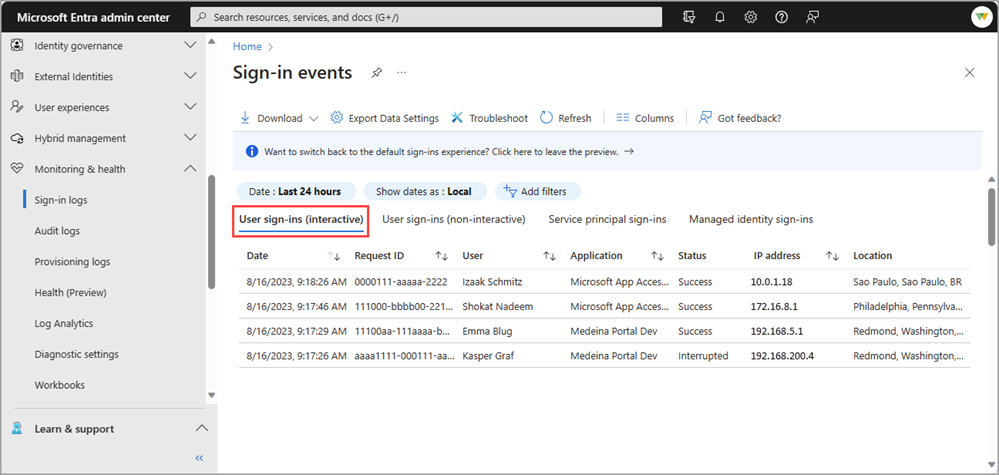Note
Access to this page requires authorization. You can try signing in or changing directories.
Access to this page requires authorization. You can try changing directories.
Microsoft Entra monitoring and health provides several types of sign-in logs to help you monitor the health of your tenant. The interactive user sign-ins are the default view in the Microsoft Entra admin center.
What is an interactive user sign-in?
Interactive sign-ins are performed by a user. They provide an authentication factor to Microsoft Entra ID. That authentication factor could also interact with a helper app, such as the Microsoft Authenticator app. Users can provide passwords, responses to MFA challenges, biometric factors, or QR codes to Microsoft Entra ID or to a helper app. This log also includes federated sign-ins from identity providers that are federated to Microsoft Entra ID.
Log details
The following examples show the type of information captured in the interactive user sign-in logs:
- A user provides username and password in the Microsoft Entra sign-in screen.
- A user passes an SMS MFA challenge.
- A user provides a biometric gesture to unlock their Windows PC with Windows Hello for Business.
- A user is federated to Microsoft Entra ID with an AD FS SAML assertion.
In addition to the default fields, the interactive sign-in logs also show:
- The sign-in location
- Whether Conditional Access was applied
- Cross-tenant access details, such as home and resource tenant IDs
Note
Entries in the sign-in logs are system generated and can't be changed or deleted.
Special considerations
Partner access to downstream tenant resources
The interactive sign-in logs now include details about when a partner accesses a downstream tenant's resources. By looking at the Cross tenant access type, Home tenant ID, and Resource tenant ID columns, which are now visible by default, you can see when a partner logs into a downstream tenant resource.
- Filter on Service Provider in the Cross tenant access type column to isolate events related to partner sign-ins.
- Compare the details in the Home tenant ID and Resource tenant ID columns to identify sign-ins coming from your partner's tenant to the downstream tenant.
Non-interactive sign-ins on the interactive sign-in logs
Previously, some non-interactive sign-ins were included in the interactive user sign-in log for better visibility. This increased visibility was necessary before the non-interactive user sign-in logs were introduced in November 2020. Non-interactive sign-ins involving FIDO2 keys were previously marked as interactive sign-ins, even though they were technically non-interactive. As of April 11, 2025, all new sign-ins that obtain a refresh token with FIDO2 keys are now logged in the non-interactive sign-in logs.
Passthrough sign-ins
Microsoft Entra ID issues tokens for authentication and authorization. In some situations, a user who is signed in to the Contoso tenant might try to access resources in the Fabrikam tenant, where they don't have access. A no-authorization token called a passthrough token, is issued to the Fabrikam tenant. The passthrough token doesn't allow the user to access any resources.
Previously, when reviewing the logs for this situation, the sign-in logs for the home tenant (in this scenario, Contoso) didn't show a sign-in attempt because the token wasn't granting access to a resource with any claims. The sign-in token was only used to display the appropriate failure message.
Passthrough sign-in attempts now appear in the home tenant sign-in logs and any relevant tenant restriction sign-in logs. This update provides more visibility into user sign-in attempts from your users and deeper insights into your tenant restriction policies.
The crossTenantAccessType property now shows passthrough to differentiate passthrough sign-ins and is available in the Microsoft Entra admin center and Microsoft Graph.
First-party, app-only service principal sign-ins
The service principal sign-in logs don't include first-party, app-only sign-in activity. This type of activity happens when first-party apps get tokens for an internal Microsoft job where there's no direction or context from a user. We exclude these logs so you're not paying for logs related to internal Microsoft tokens within your tenant.
You might identify Microsoft Graph events that don't correlate to a service principal sign-in if you're routing MicrosoftGraphActivityLogs with SignInLogs to the same Log Analytics workspace. This integration allows you to cross reference the token issued for the Microsoft Graph API call with the sign-in activity. The UniqueTokenIdentifier for sign-in logs and the SignInActivityId in the Microsoft Graph activity logs would be missing from the service principal sign-in logs.
Conditional Access
Sign-ins that show Not applied for Conditional Access can be difficult to interpret. If the sign-in is interrupted, the sign-in appears on the logs but shows Not applied for Conditional Access. Another common scenario is signing in to Windows Hello for Business. This sign-in doesn't have Conditional Access applied because the user is signing in to the device, not to cloud resources protected by Conditional Access.
TimeGenerated field
If you're integrating your sign-in logs with Azure Monitor logs and Log Analytics, you might notice that the TimeGenerated field in the logs doesn't match the time the sign-in occurred. This discrepancy is due to the way the logs are ingested into Azure Monitor. The TimeGenerated field is the time the entry was received and published by Log Analytics, not the time the sign-in occurred. The CreatedDateTime field in the logs shows the time the sign-in occurred.
Similarly, risky sign-in events also display TimeGenerated as the time when the risky event was detected, not when the sign-in occurred. To find the actual sign-in time, you can use the CorrelationId to find the sign-in event in the logs and locate the sign-in time.
